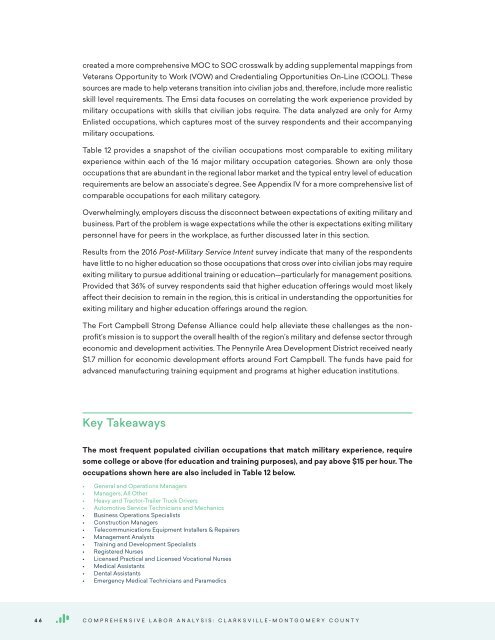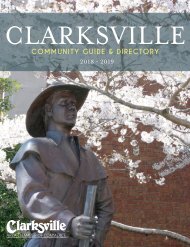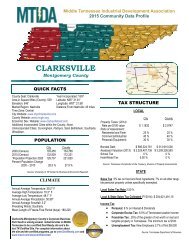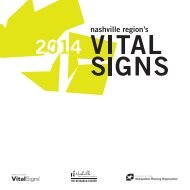Clarksville- Main File
Create successful ePaper yourself
Turn your PDF publications into a flip-book with our unique Google optimized e-Paper software.
created a more comprehensive MOC to SOC crosswalk by adding supplemental mappings from<br />
Veterans Opportunity to Work (VOW) and Credentialing Opportunities On-Line (COOL). These<br />
sources are made to help veterans transition into civilian jobs and, therefore, include more realistic<br />
skill level requirements. The Emsi data focuses on correlating the work experience provided by<br />
military occupations with skills that civilian jobs require. The data analyzed are only for Army<br />
Enlisted occupations, which captures most of the survey respondents and their accompanying<br />
military occupations.<br />
Table 12 provides a snapshot of the civilian occupations most comparable to exiting military<br />
experience within each of the 16 major military occupation categories. Shown are only those<br />
occupations that are abundant in the regional labor market and the typical entry level of education<br />
requirements are below an associate’s degree. See Appendix IV for a more comprehensive list of<br />
comparable occupations for each military category.<br />
Overwhelmingly, employers discuss the disconnect between expectations of exiting military and<br />
business. Part of the problem is wage expectations while the other is expectations exiting military<br />
personnel have for peers in the workplace, as further discussed later in this section.<br />
Results from the 2016 Post-Military Service Intent survey indicate that many of the respondents<br />
have little to no higher education so those occupations that cross over into civilian jobs may require<br />
exiting military to pursue additional training or education—particularly for management positions.<br />
Provided that 36% of survey respondents said that higher education offerings would most likely<br />
affect their decision to remain in the region, this is critical in understanding the opportunities for<br />
exiting military and higher education offerings around the region.<br />
The Fort Campbell Strong Defense Alliance could help alleviate these challenges as the nonprofit’s<br />
mission is to support the overall health of the region’s military and defense sector through<br />
economic and development activities. The Pennyrile Area Development District received nearly<br />
$1.7 million for economic development efforts around Fort Campbell. The funds have paid for<br />
advanced manufacturing training equipment and programs at higher education institutions.<br />
Key Takeaways<br />
The most frequent populated civilian occupations that match military experience, require<br />
some college or above (for education and training purposes), and pay above $15 per hour. The<br />
occupations shown here are also included in Table 12 below.<br />
• General and Operations Managers<br />
• Managers, All Other<br />
• Heavy and Tractor-Trailer Truck Drivers<br />
• Automotive Service Technicians and Mechanics<br />
• Business Operations Specialists<br />
• Construction Managers<br />
• Telecommunications Equipment Installers & Repairers<br />
• Management Analysts<br />
• Training and Development Specialists<br />
• Registered Nurses<br />
• Licensed Practical and Licensed Vocational Nurses<br />
• Medical Assistants<br />
• Dental Assistants<br />
• Emergency Medical Technicians and Paramedics<br />
46<br />
COMPREHENSIVE LABOR ANALYSIS: CLARKSVILLE-MONTGOMERY COUNTY












